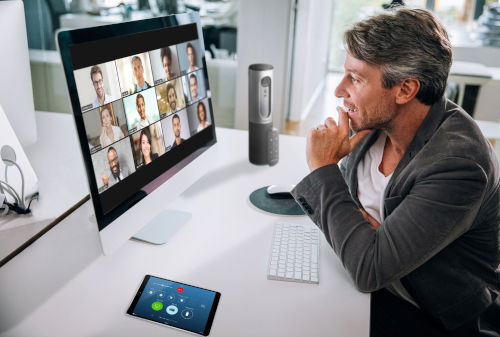Surprising advantages of telepsychiatry

According to research, around one billion people globally have a mental or substance use disorder. This highlights the pressure psychiatrists are under to see more patients. With many psychiatrists already facing long waiting times and seeing numerous patients each day, how can they possibly find time to make themselves available to more patients? Dr. Jake Behrens MD. is working to use telehealth to be there and serve his patients.
 What is telepsychiatry?
What is telepsychiatry?
In essence, telepsychiatry is any way to provide psychiatric services over a distance. It’s using secure online video and audio, like Skype or FaceTime, so you’re able to expand your range and reach people in settings you otherwise wouldn’t be able to. With telepsychiatry, patients don’t have to commute or deal with waiting rooms, which means they can get back to work or home quicker with less disruption to daily life. There are other benefits too. If you’re sick with a cough for example, you can still make your appointment. If the weather is bad – where I am in Wisconsin where we get snowstorms – no one must miss an appointment because we’re all able to meet directly online from a phone or computer. I really like it.
Telepsychiatry is not just replicating a regular visit. The question we’re answering with telepsychiatry is how can you provide care over a distance and make yourself more available? Now, with this form of psychiatry, you can also include secure messaging, add instant recommendations to community support teams, or roll out a rural intensive outpatient group where you can manage and provide psychiatric expertise to places where they may not have had the resources to run such groups before. That timely response to patients is now possible irrespective of location. This is how, I believe, we can work in rural areas, in prisons and other environments that are traditionally quite difficult to provide services for.
Are there any specific types of patients that benefit more from telepsychiatry as opposed to coming to visit you in person?
Everyone can. Ideally, those who have a long journey to get to their nearest clinic or who don’t have access to psychiatric services where they are. Telepsychiatry is great for those who work a lot. People have busy lives, they have children, they have things going on, they have lives beyond psychiatric appointments. Before telepsychiatry, patients were missing out on all the other parts of life because of all this disruption of having to get to a clinic.
Telepsychiatry also has advantages over in person visits because you are able to bring other family members, professionals and other collateral into the conversation – much faster than if it was in person. Once you set up an online visit, you can have everybody join the same conversation. Take school as an example. If you have a physical appointment you must take time off work to take your child to see a psychiatrist and then take them back and then go back to work. That’s a lot of travel and disruption to everyone’s schedules. With technology, parents can stay at work and join a video call from their office. The child simply goes from the classroom to the counselor’s office and joins the call – now you’re connected with minimal disruption, even including a professional from the school in the visit. With ADHD assessments, we as psychiatrists need to assess patient’s behavior in more than one setting, so having the parents and a teacher on the same call is particularly useful.
What are the challenges of telepsychiatry?
The biggest challenge is trying to look at things that require a physical exam. You have to find other ways of getting it. For example, have you thought of ways the patient can use their own monitoring devices? Are they able to do it from the pharmacy? Are they able to do it at a different place? As telepsychiatry evolves, these processes will become mainstream.
Much of the work I do is around psychoeducation. In effect, I’m teaching patients new skills using the video tools at my disposal. On a video call, I can share what’s on my screen to show the patient data in their reports, to show them what’s going on with them. I usually draw diagrams and jot down notes to go through this information.
You may assume that this is easier to do in person, in a clinical setting. In fact, I find my own office the most challenging place to go through a patient evaluation. Although my office is comfortable, I’m sitting there holding up my laptop, trying to scroll with two fingers or trying to draw on paper on a clipboard or hovering over a coffee table. Conversely, when I do this online, we are both simultaneously looking at each other as well as the shared screen in front of us. I’m able to review all the data while I’m speaking without breaking eye contact. Then, when I need to share data, we’re already looking at the same screen. We don’t have to turn our heads immediately right in front of us. I’m able to draw, I’m able to use the screen like a whiteboard and I can also share my screen. It is far easier.
I’ve changed my practice, so the big evaluations are online, which makes scheduling more flexible for me and does rely on regular clinic hours. Now we just meet in person to formally establish care – you can’t prescribe controlled substances simply over a video call for instance and may need repeat in person visits depending on your state laws. I then use these in-person meetings for shorter appointments to check vital signs and give them the tools to take blood pressure from home and go over everything that we’ve talked about online.
Is telepsychiatry more practical for those with ADHD?
I can get them online much quicker and I can call them to remind them. If they are late or forget an appointment, they don’t have to go anywhere – they can join the call on their phone right then and there. My no-show rates have dropped compared to when I was working for a large institution. It also helps that I’m using software to schedule appointments. My patients can schedule their own appointments directly online. They can then easily add to their calendars, cancel, reschedule all on their own time. They get automatic email reminders and text message reminders for appointments too. I feel that this approach, provided you follow the security measures and HIPAA, is the way forward.
We should look towards customer service organizations to see what people are doing to innovate. People are scheduling spa appointments and fitness appointments online or talking to a customer service representative online to get their iPhone fixed. We as healthcare professionals must compete from a customer service perspective. It is often the patient experience that we don’t look at. Nowadays, clinicians are rushing to new medical treatments and technology and a lot of people far smarter than myself are making great strides. Where I can differentiate myself is by increasing my availability to my patients, so that I can be there for them when they need it. I’m able to make changes to treatment, track the outcomes, and do it in a means more efficient and responsive for both myself and my patients. All is an evolutionary work in progress and there are certainly no easy answers and no one size fits all approaches. Just as different patients may require different approaches, so too do physicians. It’s about finding the best fit for the given clinician and patient.
How does telepsychiatry benefit you as the clinician?
The main benefit is that I can work in many different settings. I have worked for many different telemedicine companies; I also work in a rural geriatric intensive outpatient program. I see all my own patients and I even free up time to take business meetings where I advise other health tech companies. With telepsychiatry, I can fit everybody into the same schedule. I sit at one desk and everybody’s schedules are in the same calendar. If I go to other people’s offices or even just a different place to see patients, I would have to block out far more time just for the commuting there and back. I’m never late for appointments. I don’t have to worry about the weather – I don’t have to make those difficult decisions. And even today, with a big snowstorm, I don’t even have to think about whether I can make it to work or how my patients will manage on the roads.
For my patients, I don’t want to take away their time. I want them to focus on work, home and their family, far more than focusing on me.
Learn about our objective ADHD tests.
